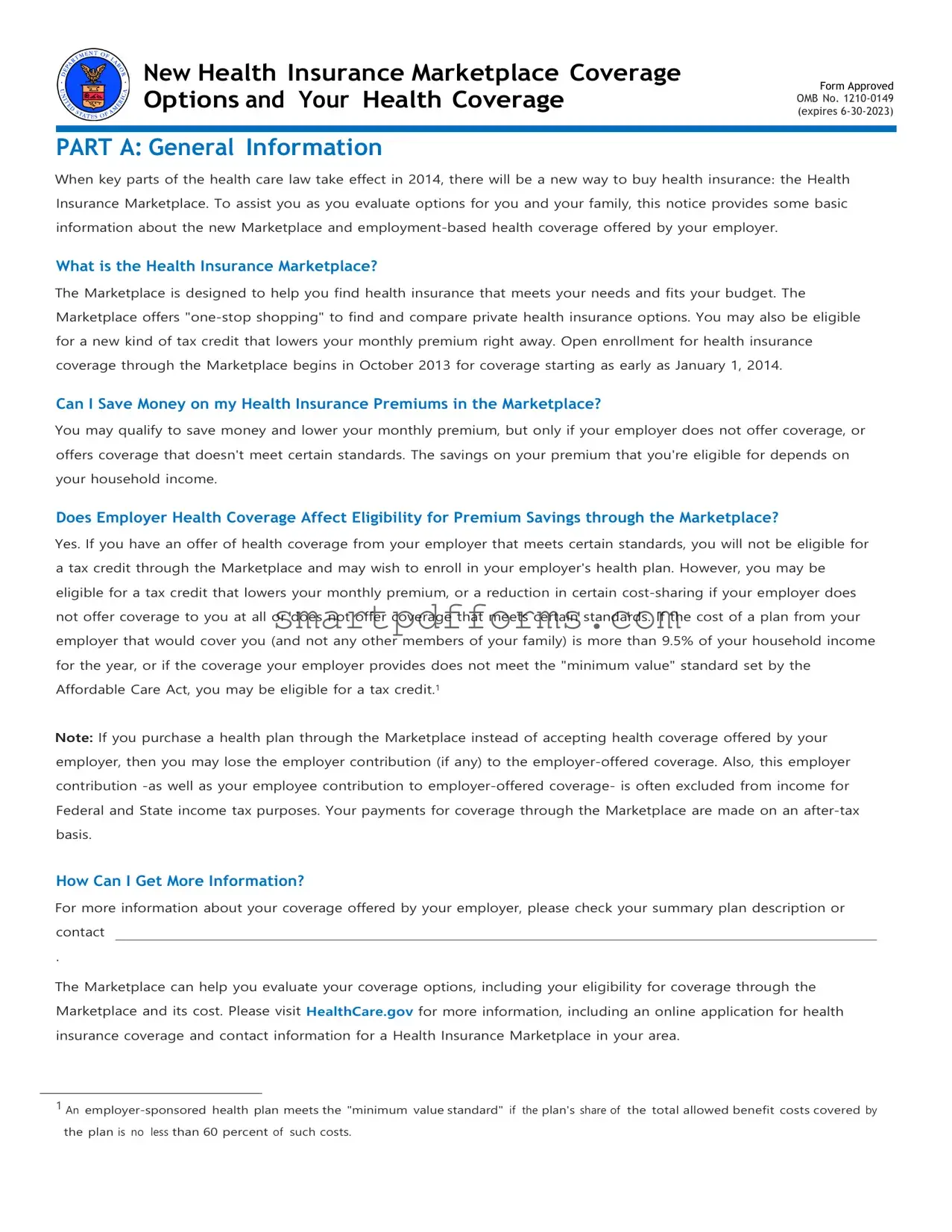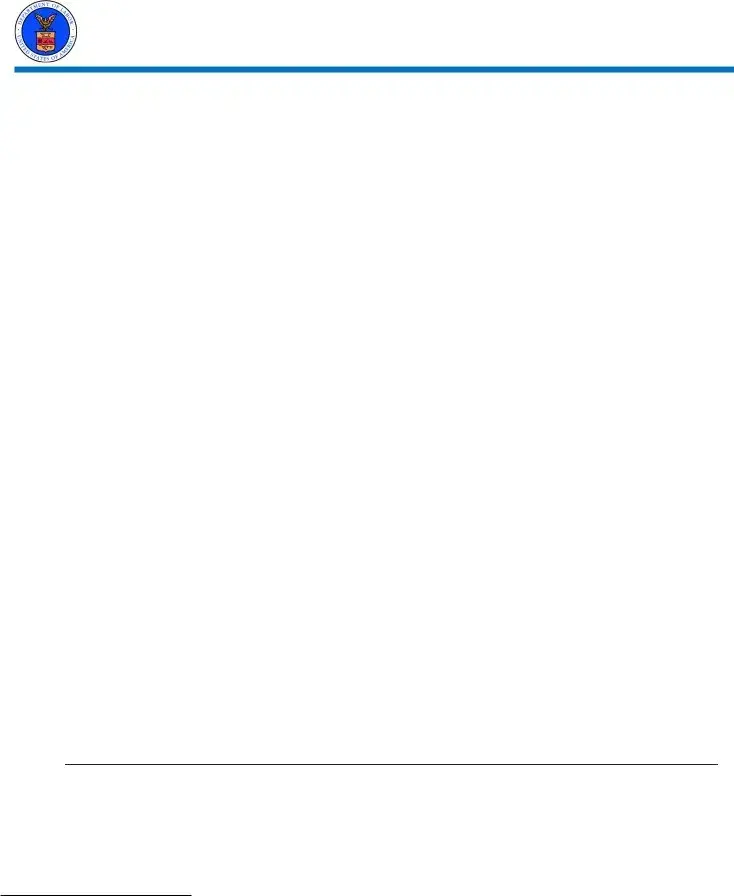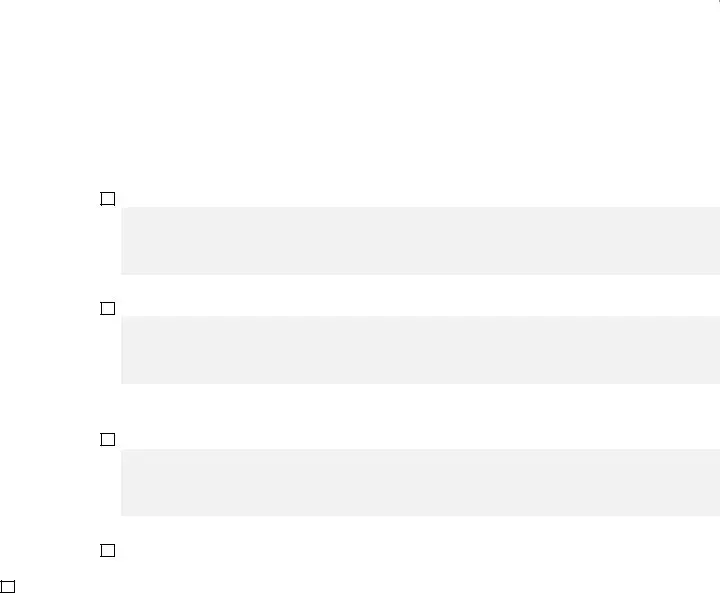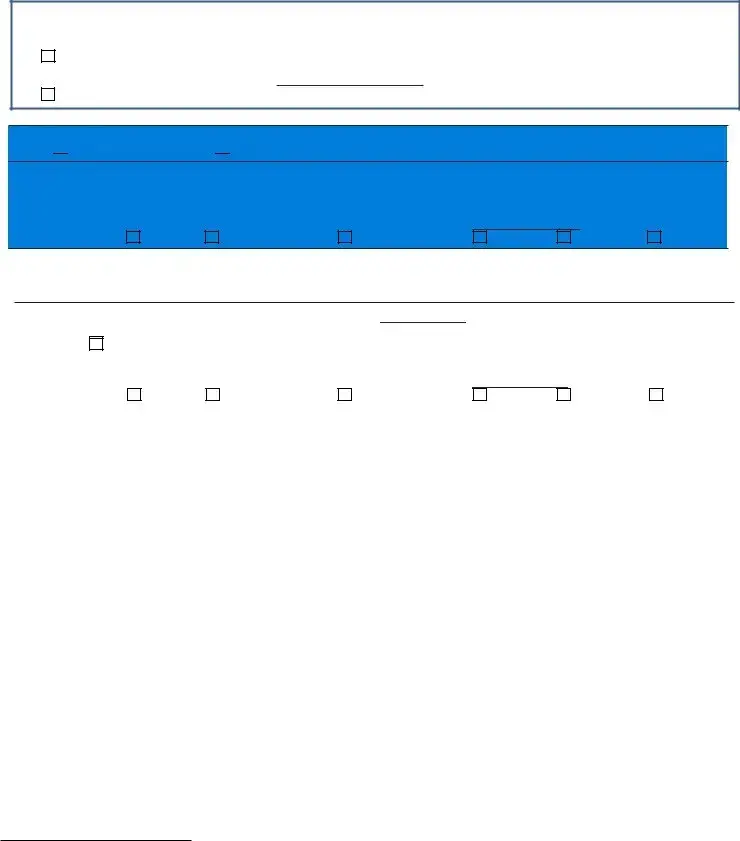New Health Insurance Marketplace Coverage Options and Your Health Coverage
Form Approved
OMB No. 1210-0149
(expires 6-30-2023)
PART A: General Information
When key parts of the health care law take effect in 2014, there will be a new way to buy health insurance: the Health Insurance Marketplace. To assist you as you evaluate options for you and your family, this notice provides some basic information about the new Marketplace and employmentbased health coverage offered by your employer.
What is the Health Insurance Marketplace?
The Marketplace is designed to help you find health insurance that meets your needs and fits your budget. The Marketplace offers "one-stop shopping" to find and compare private health insurance options. You may also be eligible for a new kind of tax credit that lowers your monthly premium right away. Open enrollment for health insurance coverage through the Marketplace begins in October 2013 for coverage starting as early as January 1, 2014.
Can I Save Money on my Health Insurance Premiums in the Marketplace?
You may qualify to save money and lower your monthly premium, but only if your employer does not offer coverage, or offers coverage that doesn't meet certain standards. The savings on your premium that you're eligible for depends on your household income.
Does Employer Health Coverage Affect Eligibility for Premium Savings through the Marketplace?
Yes. If you have an offer of health coverage from your employer that meets certain standards, you will not be eligible for a tax credit through the Marketplace and may wish to enroll in your employer's health plan. However, you may be eligible for a tax credit that lowers your monthly premium, or a reduction in certain cost-sharing if your employer does not offer coverage to you at all or does not offer coverage that meets certain standards. If the cost of a plan from your employer that would cover you (and not any other members of your family) is more than 9.5% of your household income for the year, or if the coverage your employer provides does not meet the "minimum value" standard set by the Affordable Care Act, you may be eligible for a tax credit.1
Note: If you purchase a health plan through the Marketplace instead of accepting health coverage offered by your employer, then you may lose the employer contribution (if any) to the employer-offered coverage. Also, this employer contribution -as well as your employee contribution to employer-offered coverage- is often excluded from income for Federal and State income tax purposes. Your payments for coverage through the Marketplace are made on an after-tax basis.
How Can I Get More Information?
For more information about your coverage offered by your employer, please check your summary plan description or contact
.
The Marketplace can help you evaluate your coverage options, including your eligibility for coverage through the Marketplace and its cost. Please visit HealthCare.gov for more information, including an online application for health insurance coverage and contact information for a Health Insurance Marketplace in your area.
1An employer-sponsored health plan meets the "minimum value standard" if the plan's share of the total allowed benefit costs covered by the plan is no less than 60 percent of such costs.
PART B: Information About Health Coverage Offered by Your Employer
This section contains information about any health coverage offered by your employer. If you decide to complete an application for coverage in the Marketplace, you will be asked to provide this information. This information is numbered to correspond to the Marketplace application.
3. Employer name |
|
|
|
4. |
Employer Identification Number (EIN) |
5. Employer address |
|
|
|
6. |
Employer phone number |
|
|
|
|
|
|
7. City |
|
|
8. State |
9. ZIP code |
10. Who can we contact about employee health coverage at this job? |
|
|
|
|
|
|
|
11. Phone number (if different from above) |
|
12. Email address |
|
|
|
|
|
|
|
|
|
|
|
|
Here is some basic information about health coverage offered by this employer:
•As your employer, we offer a health plan to:
All employees. Eligible employees are:
Some employees. Eligible employees are:
•With respect to dependents:
We do offer coverage. Eligible dependents are:
We do not offer coverage.
If checked, this coverage meets the minimum value standard, and the cost of this coverage to you is intended to be affordable, based on employee wages.
**Even if your employer intends your coverage to be affordable, you may still be eligible for a premium discount through the Marketplace. The Marketplace will use your household income, along with other factors, to determine whether you may be eligible for a premium discount. If, for example, your wages vary from week to week (perhaps you are an hourly employee or you work on a commission basis), if you are newly employed mid-year, or if you have other income losses, you may still qualify for a premium discount.
If you decide to shop for coverage in the Marketplace, HealthCare.gov will guide you through the process. Here's the employer information you'll enter when you visit HealthCare.gov to find out if you can get a tax credit to lower your monthly premiums.
The information below corresponds to the Marketplace Employer Coverage Tool. Completing this section is optional for employers, but will help ensure employees understand their coverage choices.
13. Is the employee currently eligible for coverage offered by this employer, or will the employee be eligible in the next 3 months?
Yes (Continue)
13a. If the employee is not eligible today, including as a result of a waiting or probationary period, when is the
employee eligible for coverage?(mm/dd/yyyy) (Continue) No (STOP and return this form to employee)
14.Does the employer offer a health plan that meets the minimum value standard*?
 Yes (Go to question 15)
Yes (Go to question 15)  No (STOP and return form to employee)
No (STOP and return form to employee)
15.For the lowest-cost plan that meets the minimum value standard* offered only to the employee (don't include family plans): If the employer has wellness programs, provide the premium that the employee would pay if he/ she received the maximum discount for any tobacco cessation programs, and didn't receive any other discounts based on
wellness programs. |
|
|
|
|
|
a. How much would the employee have to pay in premiums for this plan? $ |
|
|
|
b. How often? |
Weekly |
Every 2 weeks |
Twice a month |
Monthly |
Quarterly |
Yearly |
If the plan year will end soon and you know that the health plans offered will change, go to question 16. If you don't know, STOP and return form to employee.
16.What change will the employer make for the new plan year?
 Employer won't offer health coverage
Employer won't offer health coverage
Employer will start offering health coverage to employees or change the premium for the lowest-cost plan available only to the employee that meets the minimum value standard.* (Premium should reflect the discount for wellness programs. See question 15.)
a. How much would the employee have to pay in premiums for this plan? $ |
|
|
|
b. How often? |
Weekly |
Every 2 weeks |
Twice a month |
Monthly |
Quarterly |
Yearly |
•An employer-sponsored health plan meets the "minimum value standard" if the plan's share of the total allowed benefit costs covered by the plan is no less than 60 percent of such costs (Section 36B(c)(2)(C)(ii) of the Internal Revenue Code of 1986)




 Yes (Go to question 15)
Yes (Go to question 15)  No (STOP and return form to employee)
No (STOP and return form to employee) Employer won't offer health coverage
Employer won't offer health coverage